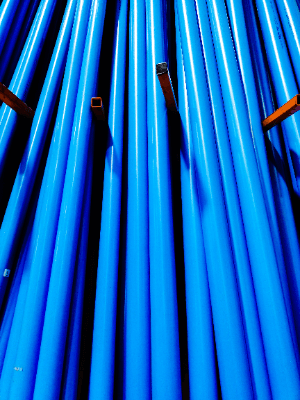What Is Polyvinyl Chloride (PVC)?

Polyvinyl chloride, also known as PVC, is a synthetic resin.
By adding additives such as plasticizers, various properties can be obtained. For this reason, it is used as a raw material for a wide variety of products, including hard plastics, soft plastics, and rubber.
Uses of PVC
PVC is used in various applications because it is inexpensive, easy to process, and can develop a variety of properties by changing additives. PVCs are broadly classified into rigid PVC and flexible PVC, each of which has different applications.
1. Rigid PVC
Rigid PVC has a plasticizer content of 10% or less. Major applications include signboards and signs, pipes and fittings for water and sewage pipes, piping materials for corrosive gases and chemicals, and conduits for electric wires and wiring.
2. Flexible PVC
Flexible PVC contains 25~50% plasticizer. It is mainly available in sheet form (0.2mm or thicker), film form (0.2mm or thicker), leather (with fabric backing), and extruded forms. The applications for each are as follows:
- Sheet Form: Handbags, belts, slippers, cushioned flooring, floating bags
- Film: Raincoats, boots, disposable gloves, umbrellas, food packaging, agricultural film, and clothing
- Leather: Vehicle interiors, furniture, bags, clothing
- Extruded: Textiles, electrical wire sheathing, flexible gas pipes, garden hoses
Properties of PVC
The molecular structure of PVC is polymers formed by the polymerization of vinyl chloride monomers. Most products are straight polymers made solely from PVC monomers. Copolymers copolymerized with other monomers such as vinyl acetate and ethylene vinylidene chloride are also available.
PVC products are produced by blending the above PVC polymers with stabilizers, plasticizers, colorants, and other additives using various processing and molding methods. The main feature of PVC is that by changing the type and amount of additives, a wide range of functions can be achieved, such as hard plastic, soft plastic, and rubber.
Characteristics of PVC
The following is a comparison of PVC’s characteristics with those of other general-purpose plastics, such as polyethylene (PE), polypropylene (PP), and polystyrene (PS).
1. Advantages
- Possessing carbon-chlorine bonds, polyvinyl chloride (PVC) has excellent chemical stability. It also has excellent flame resistance and durability.
- Compared to other resins, it has low crystallinity and contains a polar group called a carbon-chlorine bond, making it miscible with various substances.
- It exhibits high resistance to acids, bases, and most inorganic chemicals. When it comes to organic solvents, it dissolves in solvents containing aromatic rings, like toluene, ketones such as acetone, and cyclic ethers like tetrahydrofuran. However, it maintains a relatively high resistance to other types of chemicals.
2. Disadvantages
- Compared to resins such as polyethylene, it is inferior in impact resistance. It is brittle and cracks easily, especially at low temperatures. However, it is possible to increase impact resistance by adding plasticizers.
- When soft PVC products are used for a long period of time, the additives inside may ooze or volatilize on the surface.
Other Information on PVC
1. How PVC Are Manufactured
PVC is made by polymerization of vinyl chloride monomers, and industrial manufacturing methods include suspension polymerization, precipitation polymerization, and emulsion polymerization.
Suspension Polymerization
Vinyl chloride monomer, polymerization initiator, and water are mixed and heated for polymerization in a pressurized polymerization tank. After the reaction, a slurry of PVC resin dispersed in water is obtained. After removing the remaining monomer, the powdered PVC powder is obtained by dehydration and drying.
Precipitation Polymerization
This is a method in which polymerization is carried out in a solvent in which the vinyl chloride monomer is dissolved but PVC is not. When the vinyl chloride monomer, initiator, and solvent are mixed and polymerized at a low temperature, PVC precipitates. This mixture is filtered to obtain a low-polymerization PVC powder.
Emulsion Polymerization
This is a method of polymerization in which vinyl chloride monomers, surfactants, water, and a water-soluble initiator are mixed. The monomer is emulsified in water and polymerized in the emulsion droplets. To recover the polymer after polymerization, the emulsifying and dispersing effect of the surfactant is eliminated by the addition of salt or acid, and the polymer is agglomerated, followed by dehydration and drying to obtain PVC powder.
2. Safety of PVCs
PVCs are widely used for daily necessities such as food and toys. For this reason, various laws and regulations set standards, and industry associations have established voluntary standards to ensure the safety of PVCs.
For example, for products that come in contact with food such as plastic wrap, some laws require that the amount of residual vinyl chloride monomer be less than 1ppm. Also, the use of phthalate esters used in plasticizers is prohibited by certain laws. In addition, PVC used in blood bags and other products is subject to various standards.